Zhiyu Wang
AirFed: Federated Graph-Enhanced Multi-Agent Reinforcement Learning for Multi-UAV Cooperative Mobile Edge Computing
Oct 27, 2025Abstract:Multiple Unmanned Aerial Vehicles (UAVs) cooperative Mobile Edge Computing (MEC) systems face critical challenges in coordinating trajectory planning, task offloading, and resource allocation while ensuring Quality of Service (QoS) under dynamic and uncertain environments. Existing approaches suffer from limited scalability, slow convergence, and inefficient knowledge sharing among UAVs, particularly when handling large-scale IoT device deployments with stringent deadline constraints. This paper proposes AirFed, a novel federated graph-enhanced multi-agent reinforcement learning framework that addresses these challenges through three key innovations. First, we design dual-layer dynamic Graph Attention Networks (GATs) that explicitly model spatial-temporal dependencies among UAVs and IoT devices, capturing both service relationships and collaborative interactions within the network topology. Second, we develop a dual-Actor single-Critic architecture that jointly optimizes continuous trajectory control and discrete task offloading decisions. Third, we propose a reputation-based decentralized federated learning mechanism with gradient-sensitive adaptive quantization, enabling efficient and robust knowledge sharing across heterogeneous UAVs. Extensive experiments demonstrate that AirFed achieves 42.9% reduction in weighted cost compared to state-of-the-art baselines, attains over 99% deadline satisfaction and 94.2% IoT device coverage rate, and reduces communication overhead by 54.5%. Scalability analysis confirms robust performance across varying UAV numbers, IoT device densities, and system scales, validating AirFed's practical applicability for large-scale UAV-MEC deployments.
SARCLIP: A Vision Language Foundation Model for Semantic Understanding and Target Recognition in SAR Imagery
Oct 26, 2025Abstract:Synthetic Aperture Radar (SAR) has emerged as a crucial imaging modality due to its all-weather capabilities. While recent advancements in self-supervised learning and Masked Image Modeling (MIM) have paved the way for SAR foundation models, these approaches primarily focus on low-level visual features, often overlooking multimodal alignment and zero-shot target recognition within SAR imagery. To address this limitation, we construct SARCLIP-1M, a large-scale vision language dataset comprising over one million text-image pairs aggregated from existing datasets. We further introduce SARCLIP, the first vision language foundation model tailored for the SAR domain. Our SARCLIP model is trained using a contrastive vision language learning approach by domain transferring strategy, enabling it to bridge the gap between SAR imagery and textual descriptions. Extensive experiments on image-text retrieval and zero-shot classification tasks demonstrate the superior performance of SARCLIP in feature extraction and interpretation, significantly outperforming state-of-the-art foundation models and advancing the semantic understanding of SAR imagery. The code and datasets will be released soon.
MoRE-GNN: Multi-omics Data Integration with a Heterogeneous Graph Autoencoder
Oct 08, 2025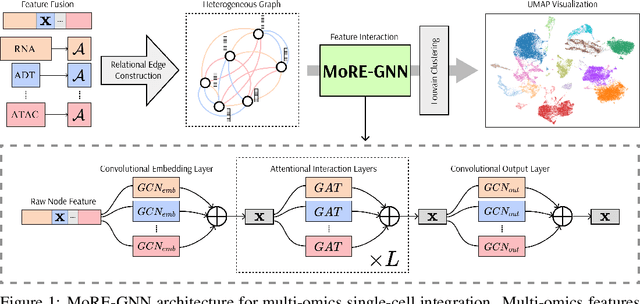
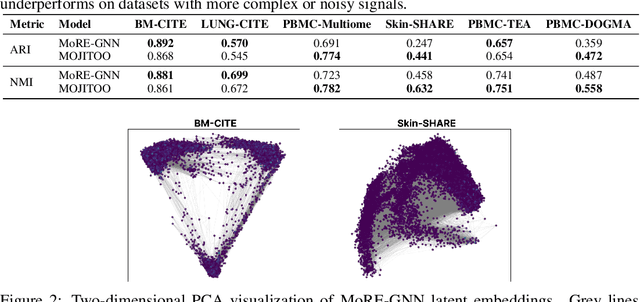

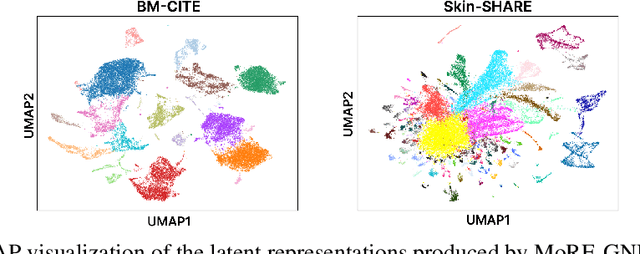
Abstract:The integration of multi-omics single-cell data remains challenging due to high-dimensionality and complex inter-modality relationships. To address this, we introduce MoRE-GNN (Multi-omics Relational Edge Graph Neural Network), a heterogeneous graph autoencoder that combines graph convolution and attention mechanisms to dynamically construct relational graphs directly from data. Evaluations on six publicly available datasets demonstrate that MoRE-GNN captures biologically meaningful relationships and outperforms existing methods, particularly in settings with strong inter-modality correlations. Furthermore, the learned representations allow for accurate downstream cross-modal predictions. While performance may vary with dataset complexity, MoRE-GNN offers an adaptive, scalable and interpretable framework for advancing multi-omics integration.
MARS2 2025 Challenge on Multimodal Reasoning: Datasets, Methods, Results, Discussion, and Outlook
Sep 17, 2025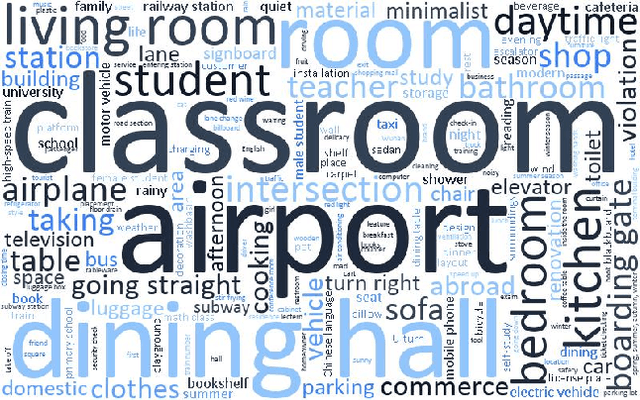
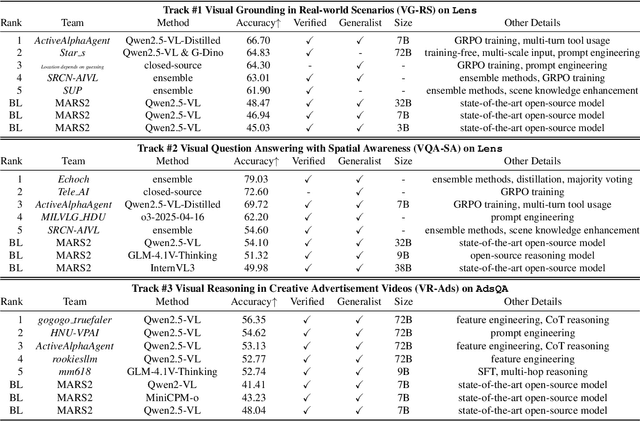
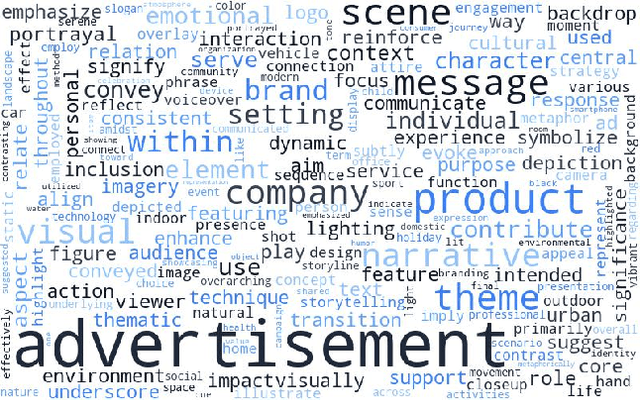

Abstract:This paper reviews the MARS2 2025 Challenge on Multimodal Reasoning. We aim to bring together different approaches in multimodal machine learning and LLMs via a large benchmark. We hope it better allows researchers to follow the state-of-the-art in this very dynamic area. Meanwhile, a growing number of testbeds have boosted the evolution of general-purpose large language models. Thus, this year's MARS2 focuses on real-world and specialized scenarios to broaden the multimodal reasoning applications of MLLMs. Our organizing team released two tailored datasets Lens and AdsQA as test sets, which support general reasoning in 12 daily scenarios and domain-specific reasoning in advertisement videos, respectively. We evaluated 40+ baselines that include both generalist MLLMs and task-specific models, and opened up three competition tracks, i.e., Visual Grounding in Real-world Scenarios (VG-RS), Visual Question Answering with Spatial Awareness (VQA-SA), and Visual Reasoning in Creative Advertisement Videos (VR-Ads). Finally, 76 teams from the renowned academic and industrial institutions have registered and 40+ valid submissions (out of 1200+) have been included in our ranking lists. Our datasets, code sets (40+ baselines and 15+ participants' methods), and rankings are publicly available on the MARS2 workshop website and our GitHub organization page https://github.com/mars2workshop/, where our updates and announcements of upcoming events will be continuously provided.
Topotein: Topological Deep Learning for Protein Representation Learning
Sep 04, 2025Abstract:Protein representation learning (PRL) is crucial for understanding structure-function relationships, yet current sequence- and graph-based methods fail to capture the hierarchical organization inherent in protein structures. We introduce Topotein, a comprehensive framework that applies topological deep learning to PRL through the novel Protein Combinatorial Complex (PCC) and Topology-Complete Perceptron Network (TCPNet). Our PCC represents proteins at multiple hierarchical levels -- from residues to secondary structures to complete proteins -- while preserving geometric information at each level. TCPNet employs SE(3)-equivariant message passing across these hierarchical structures, enabling more effective capture of multi-scale structural patterns. Through extensive experiments on four PRL tasks, TCPNet consistently outperforms state-of-the-art geometric graph neural networks. Our approach demonstrates particular strength in tasks such as fold classification which require understanding of secondary structure arrangements, validating the importance of hierarchical topological features for protein analysis.
BioMARS: A Multi-Agent Robotic System for Autonomous Biological Experiments
Jul 02, 2025Abstract:Large language models (LLMs) and vision-language models (VLMs) have the potential to transform biological research by enabling autonomous experimentation. Yet, their application remains constrained by rigid protocol design, limited adaptability to dynamic lab conditions, inadequate error handling, and high operational complexity. Here we introduce BioMARS (Biological Multi-Agent Robotic System), an intelligent platform that integrates LLMs, VLMs, and modular robotics to autonomously design, plan, and execute biological experiments. BioMARS uses a hierarchical architecture: the Biologist Agent synthesizes protocols via retrieval-augmented generation; the Technician Agent translates them into executable robotic pseudo-code; and the Inspector Agent ensures procedural integrity through multimodal perception and anomaly detection. The system autonomously conducts cell passaging and culture tasks, matching or exceeding manual performance in viability, consistency, and morphological integrity. It also supports context-aware optimization, outperforming conventional strategies in differentiating retinal pigment epithelial cells. A web interface enables real-time human-AI collaboration, while a modular backend allows scalable integration with laboratory hardware. These results highlight the feasibility of generalizable, AI-driven laboratory automation and the transformative role of language-based reasoning in biological research.
GraphAU-Pain: Graph-based Action Unit Representation for Pain Intensity Estimation
May 26, 2025Abstract:Understanding pain-related facial behaviors is essential for digital healthcare in terms of effective monitoring, assisted diagnostics, and treatment planning, particularly for patients unable to communicate verbally. Existing data-driven methods of detecting pain from facial expressions are limited due to interpretability and severity quantification. To this end, we propose GraphAU-Pain, leveraging a graph-based framework to model facial Action Units (AUs) and their interrelationships for pain intensity estimation. AUs are represented as graph nodes, with co-occurrence relationships as edges, enabling a more expressive depiction of pain-related facial behaviors. By utilizing a relational graph neural network, our framework offers improved interpretability and significant performance gains. Experiments conducted on the publicly available UNBC dataset demonstrate the effectiveness of the GraphAU-Pain, achieving an F1-score of 66.21% and accuracy of 87.61% in pain intensity estimation.
NTIRE 2025 challenge on Text to Image Generation Model Quality Assessment
May 22, 2025Abstract:This paper reports on the NTIRE 2025 challenge on Text to Image (T2I) generation model quality assessment, which will be held in conjunction with the New Trends in Image Restoration and Enhancement Workshop (NTIRE) at CVPR 2025. The aim of this challenge is to address the fine-grained quality assessment of text-to-image generation models. This challenge evaluates text-to-image models from two aspects: image-text alignment and image structural distortion detection, and is divided into the alignment track and the structural track. The alignment track uses the EvalMuse-40K, which contains around 40K AI-Generated Images (AIGIs) generated by 20 popular generative models. The alignment track has a total of 371 registered participants. A total of 1,883 submissions are received in the development phase, and 507 submissions are received in the test phase. Finally, 12 participating teams submitted their models and fact sheets. The structure track uses the EvalMuse-Structure, which contains 10,000 AI-Generated Images (AIGIs) with corresponding structural distortion mask. A total of 211 participants have registered in the structure track. A total of 1155 submissions are received in the development phase, and 487 submissions are received in the test phase. Finally, 8 participating teams submitted their models and fact sheets. Almost all methods have achieved better results than baseline methods, and the winning methods in both tracks have demonstrated superior prediction performance on T2I model quality assessment.
Learning from Noisy Pseudo-labels for All-Weather Land Cover Mapping
Apr 18, 2025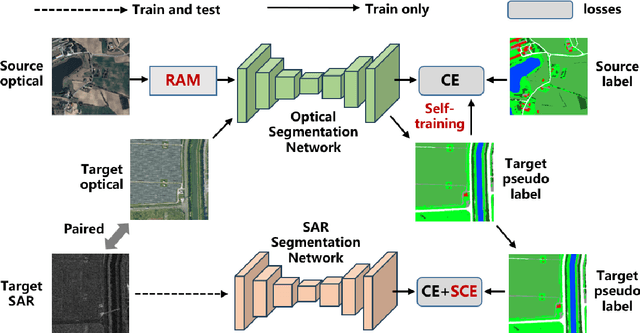

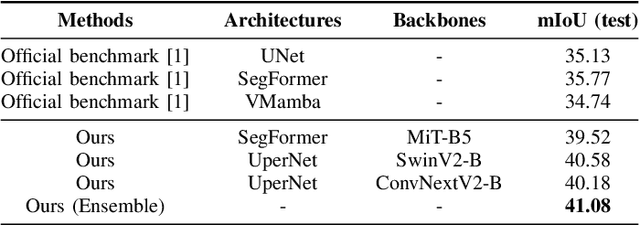
Abstract:Semantic segmentation of SAR images has garnered significant attention in remote sensing due to the immunity of SAR sensors to cloudy weather and light conditions. Nevertheless, SAR imagery lacks detailed information and is plagued by significant speckle noise, rendering the annotation or segmentation of SAR images a formidable task. Recent efforts have resorted to annotating paired optical-SAR images to generate pseudo-labels through the utilization of an optical image segmentation network. However, these pseudo-labels are laden with noise, leading to suboptimal performance in SAR image segmentation. In this study, we introduce a more precise method for generating pseudo-labels by incorporating semi-supervised learning alongside a novel image resolution alignment augmentation. Furthermore, we introduce a symmetric cross-entropy loss to mitigate the impact of noisy pseudo-labels. Additionally, a bag of training and testing tricks is utilized to generate better land-cover mapping results. Our experiments on the GRSS data fusion contest indicate the effectiveness of the proposed method, which achieves first place. The code is available at https://github.com/StuLiu/DFC2025Track1.git.
OASIS: Open Agent Social Interaction Simulations with One Million Agents
Nov 26, 2024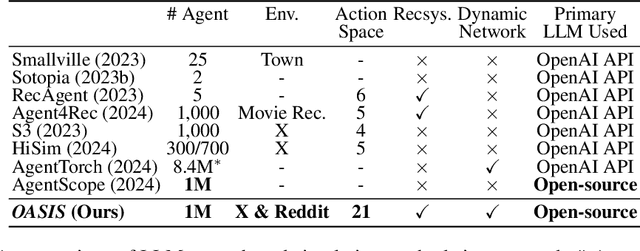
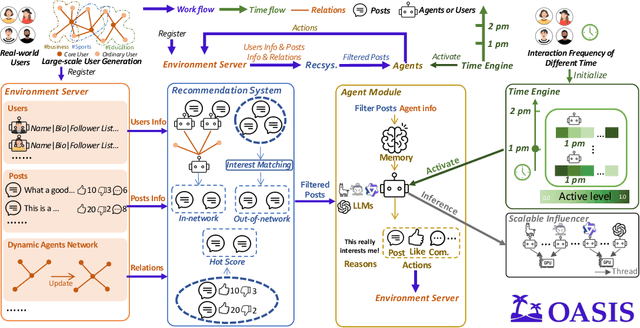

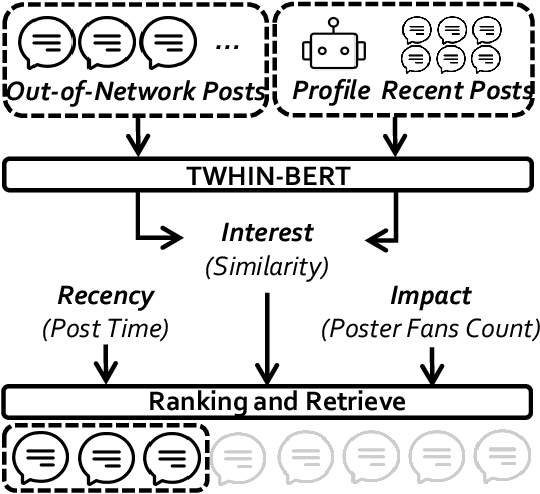
Abstract:There has been a growing interest in enhancing rule-based agent-based models (ABMs) for social media platforms (i.e., X, Reddit) with more realistic large language model (LLM) agents, thereby allowing for a more nuanced study of complex systems. As a result, several LLM-based ABMs have been proposed in the past year. While they hold promise, each simulator is specifically designed to study a particular scenario, making it time-consuming and resource-intensive to explore other phenomena using the same ABM. Additionally, these models simulate only a limited number of agents, whereas real-world social media platforms involve millions of users. To this end, we propose OASIS, a generalizable and scalable social media simulator. OASIS is designed based on real-world social media platforms, incorporating dynamically updated environments (i.e., dynamic social networks and post information), diverse action spaces (i.e., following, commenting), and recommendation systems (i.e., interest-based and hot-score-based). Additionally, OASIS supports large-scale user simulations, capable of modeling up to one million users. With these features, OASIS can be easily extended to different social media platforms to study large-scale group phenomena and behaviors. We replicate various social phenomena, including information spreading, group polarization, and herd effects across X and Reddit platforms. Moreover, we provide observations of social phenomena at different agent group scales. We observe that the larger agent group scale leads to more enhanced group dynamics and more diverse and helpful agents' opinions. These findings demonstrate OASIS's potential as a powerful tool for studying complex systems in digital environments.
 Add to Chrome
Add to Chrome Add to Firefox
Add to Firefox Add to Edge
Add to Edge